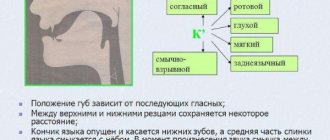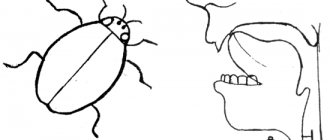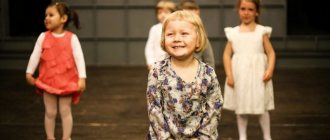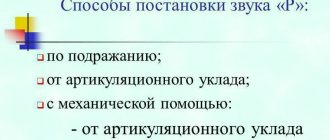Development of speech hearing
To correct the defect, it is important that the child begins to control himself - to distinguish between the correct and incorrect pronunciation of sounds. To achieve this, step-by-step work is being carried out on the development of speech hearing.
At the first stage, non-speech sounds are used - the noise of the forest, wind, rain, music. The child is asked to close his eyes and listen to what is being heard in the other room: mom is washing the dishes, dad is vacuuming. They show noise samples: crumpled paper, pouring water, tapping a pencil. Then they ask you to turn away and determine the action by ear.
The second stage is vowel discrimination. The child is shown symbols of vowel sounds and their articulation is examined. Show a picture of a bus, emphasizing that the word has a beginning, middle and end. The diagram makes it easier to understand.
The child is called a sound series (from vowels) and asked to name the first sound. Only then do they move on to using consonants. The development of speech hearing is slow.
Article:
Goal: to develop the skill of pronouncing the sound [L] in forward and backward syllables and words.
Tasks:
Correctional and educational:
- automate the sound [L] in syllables, words, sentences.
Correctional and educational:
- develop interest in activities
- the ability to control your speech.
Correctional and developmental:
- development of motor skills of the speech apparatus
- fixing the correct pronunciation of a given sound in syllables, words, sentences
- development of visual-spatial functions.
Equipment: mirror, pictures, map, diagram for sound analysis.
Progress of the lesson
1. Organizational moment.
Speech therapist: Hello! I am very glad to see you! How are you doing? How are you?
Sit comfortably, don’t forget to keep your back straight. Let's remember where each of our classes begins?! That's right, from charging. Look in the mirror and go through the motions.
2. Articulation gymnastics
Speech therapist: To speak correctly and beautifully, you need to do gymnastics for the tongue, lips and cheeks.
- "Smile-Proboscis"
- “Spatula” - “Needle”
- "Swing"
- "The steamer is humming"
- "Delicious jam"
3. Breathing exercises
Speech therapist: Look, I have this bee, let’s blow and see how it flaps its wings while flying.
Instructions: (Inhale through your nose, exhale through your mouth through your lips into a tube, do not raise your shoulders, do not puff out your cheeks)
4. Introduction to the lesson
Speech therapist: Today we have a guest in class. Listen to the riddle and try to guess who it is?
She buzzes over the flower, flies quickly towards the hive, gives her honey to the honeycomb; What is her name?! (Bee)
Speech therapist: Correct! This is a cheerful and kind bee, and her name is Lolo. She got a little lost and really wants to return to her home in her fairyland, Beeland. And she got lost because she was looking for someone who could help her remember how to pronounce the sound L.
Let's help Lolo return home and remember how to pronounce the L sound.
5. Analysis of articulation of sounds. Characteristics of sound.
Speech therapist: Tell Lolo how to correctly pronounce the sound [L].
Child: When pronouncing the sound [L], the lips are in a smile, the teeth are open, the tip of the tongue is pressed against the tubercle behind the upper teeth.
Speech therapist: Is the [L] sound consonant or vowel?
Child: Agreeable
Speech therapist: Why?
Child: The sound [L] is consonant, because there is an obstruction in the mouth.
Speech therapist: Voiced or deaf?
Child: Voiced.
Speech therapist: Why is he loud?
Child: When pronouncing the sound [L], the neck trembles.
Speech therapist: Hard or soft?
Child: Solid
Speech therapist: Well, now let's go! We have a map with which we will help Lolo get to her country. This card is unusual, you need to move the index finger of your right hand and pronounce the sound [L].
6. Automation of the sound [L] in syllables.
Speech therapist: So we got to the first point. We are greeted by a singer bee, she loves to fly on the lawn and sing songs. And she wants you to sing with her too.
la-la-la ala-ala-ala lu-lu-lu ulu-ulu-ulu ly-ly-ly yly-yly-yly lo-lo-lo olo-olo-olo
Speech therapist: Let's move on.
7. Automation of the sound [L] in words.
Speech therapist: And now we’ve reached the second point, and this bee invites you to learn how to write poetry. Think of a word that rhymes and repeat the entire poem. Don’t forget to pronounce [L] clearly and correctly.
La-la-la, delicious honey brings... Child: (bee). Lu-lu-lu, we saw... Child: (a bee).
Ly-ly-ly, we were scared... Child: (bees).
Speech therapist: And the bee also wants us to solve the puzzle. Look carefully at the cards. What is shown here. What else do you see? Right! Syllable. What word will you get if you combine a syllable with a word?
8. "Rebus"
Boo (shop) What's the word?
Ku (lak) What is the word?
Cab (onion) What is the word?
9. Physical exercise.
Speech therapist: The bee is a little tired. Let's relax with her.
Here's the bee's exercise. Do it in order. Quickly stand up and smile. Reach higher, reach higher.
Come on, straighten your shoulders, raise them and lower them. Turn left, right, touch your hands with your knees.
Speech therapist: Let's go further, to the third point.
10. Automation of sound in words.
Game “Where the sound was hidden” .
Speech therapist: This bee brought a beautiful box. Look what's in it. Yes, there are a lot of pictures here, in the name of which each object the sound [L] is hidden. Determine the place of the sound in words: at the beginning, in the middle or at the end of the word.
(Baps, horse, bicycle, donkey, football, swallow, saw, hammer, wolf, stick, chalk, flippers, bun, violet, table, hanger, bow, boat).
11. Automation of sound in sentences.
Speech therapist: Here we are almost at the country of the bee Lolo, the last point left. Here we are met by a bee who wants to make us laugh with funny suggestions. Let's listen to them and put them together correctly.
Speech therapist: Mila ate salad.
Child: Mila ate salad.
Speech therapist: Paul fell into a chair.
Child: The chair fell on the floor.
Speech therapist: Half the onion Mila.
Child: Mila, half the onion.
Child: Hurray! So we reached the country of Beeland! And they helped Lolo remember the sound L.
12. Summary of the lesson.
Speech therapist: What sound did we repeat today?
Child: Today in class we repeated the sound [L].
Speech therapist: How to pronounce it correctly?
Child: When pronouncing the sound [L], the lips are in a smile, the teeth are open, the tip of the tongue is pressed against the tubercle behind the upper teeth.
Speech therapist: What is he like?
Child: The sound [L] is consonant, hard, sonorous.
Speech therapist: Our lesson has come to an end. It's time to say goodbye to Lolo. It's time for her to return home.
Characteristics of the violation
Problems with the reproduction of the sounds “L” and “L” are called lambdacisms. There are several types of violations. With the labial, a distorted sound occurs and something similar to “U” is obtained. With labiodental it turns out “B”. With interdental, the tip of the tongue passes between the teeth.
With dysarthria, softened pronunciation of hard sounds may be observed.
Paralambdacisms are distinguished separately - replacing the sound “L” with “F”, “V”, “U”, “N” and others.
Teaching a child to speak correctly is difficult. Speech therapy adopts a step-by-step approach. Each one achieves certain goals. For successful development, you need the help of your parents. They will do homework with the preschooler.
Preparatory stage
Any sound production is carried out in individual lessons. Lifting the tip of the tongue is practiced. An approximate set of exercises:
- the mouth is wide open, the tip of the tongue licks the upper lip;
- clop like a horse, drawing the child’s attention to the immobility of the lower jaw;
- steamer - the mouth is wide open, the tongue lies behind the lower teeth, pronounce the sound “Y” for a long time;
- turkey - mouth wide open, tongue quickly running up and down along the upper lip;
- lift the tongue by the upper and lower alveoli.
It takes 2-3 months to practice articulatory gymnastics. After precise movements begin to be obtained, proceed to the next stage. All exercises must be done in front of a mirror!
To pronounce the sound “L”, a strong air stream is required. To produce it, plumes, wind blowers, and special simulators are used. Be sure to draw the child’s attention to the fact that air should not go into the cheeks.
For quick production, use the “Walk through the swamp” method. The tip of the tongue is clamped between the teeth, air goes into the cheeks. They need to be lightly struck with your fingers. You will get a squelching sound.
general information
The sound "L" belongs to sonors. To pronounce it, the organs of articulation take the following positions:
- the teeth are slightly open;
- the tip of the tongue rests on the alveoli of the upper teeth;
- the side edges leave a passage for air.
Vibration occurs due to the closure of the vocal cords. To pronounce the soft version, it is not the root of the tongue that is raised, but its back. Most often the hard sound suffers.
Normally, sonorous sounds appear at 5-6 years of age. Until this age there is no need to worry. Children can pronounce “L” and “L” poorly for a long time. You need to see a speech therapist after reaching the age of six.
Letter or sound?
Before your first speech therapy session, carefully study the theoretical material, become familiar with the basic prerequisites for the occurrence of the defect, sound production techniques and types of exercises to consolidate success.
Gaps in parents' knowledge are the main reason for the ineffectiveness of classes. First of all, remember that a speech therapist teaches you to pronounce not the letter but the sound [l]. Speech sounds in writing are indicated by letters. A letter can only be written, but not pronounced or heard. Several different sounds can be represented by one letter when written. The Russian language has more sounds than letters. By calling a sound a letter, you give your child the wrong idea about the Russian phonetic base.
Introduction to Speech
After a preschooler begins to speak clearly, it is necessary to carry out automation. It begins with straight syllables (consonant + vowel). To do this, they use walking games, marbles and other tools.
After you can pronounce it in direct syllables, take the reverse ones (vowel + consonant). Only then do they move on to words, tongue twisters and poems.
Children in the preparatory group of kindergarten are taught the concept of the sound “L” and the letter L. This makes it easier to learn to read and write at school. Parents are given advice on monitoring their children's speech.
Staging methods
After completing the preparatory stage, they begin sound production. There is no single correct method. Use all possible options.
Mechanical placement using a probe facilitates the process. A tool in the form of a wide wire frame is used. They place it under the tongue, lift the organ with it and ask the child to pronounce the sound “Y”. The result will be a distorted version of the “L” sound. Gradually the frame is moved away.
For easy perception, make a symbol picture with an airplane. Visualization makes the process of sound production easier.
It is easier to learn to pronounce sounds from interdental pronunciation. To do this, bite the tip of the tongue and pronounce “Y” for a long time. Get a hard “L” sound. In order to remove it by the teeth, use the “Snail Hidden” exercise. The sound is pulled, then the tip is sharply removed so that it slides over the teeth to the alveoli. Gradually the child will get used to the new sound.
During labial pronunciation, the speech therapist holds the lips with his fingertips and does not allow them to gather. The preschooler is taught to keep a smile and control himself through the mirror.
During the production, be sure to examine the correct articulation of sound. For this purpose, special graphic images are used. The diagram is easier for children to navigate.
Causes and types of violations
Any child can speak incorrectly. Distorted sound appears due to insufficient or unformed muscle movements. Factors influencing mobility:
- somatic health;
- state of the nervous system;
- general motor skills.
Parents often do not teach their children to chew solid food, give them breast milk for a long time or bottle feed them. The muscles do not develop, there are no precise movements of the tongue and lips.
The mobility of the tongue is limited by the short hypoglossal ligament. In severe cases, it does not allow the organ to rise; in moderate cases, a slight rise occurs.
A child may have difficulty pronouncing sounds due to poor speech hearing. It allows you to distinguish between similar phonemes. At a low level of development, sounds are mixed: instead of “L”, “V” is pronounced, etc.
There are three levels of violation:
- first, children cannot pronounce a given sound by imitation or independently;
- second – children say the sound in an isolated position;
- still others are able to say the sound in individual words, but in spontaneous speech they mix it with others.
Depending on the level, correction work is carried out. Without help, the defect will persist. An adult will be limited in his choice of work.







